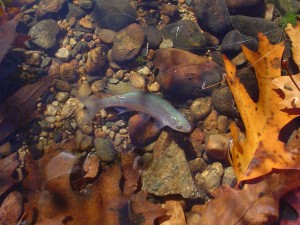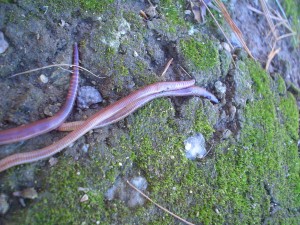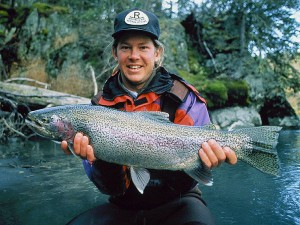If you have never caught a rainbow trout before then you are in for surprise the first time one latches onto your line. They are an aggressive freshwater fish that offers a good fight for their size. They are also one of the most colorful freshwater, which is where they received their name from. Beginners often find themselves persuing rainbow trout as they very popular in the localy stocked ponds and rivers.

Rainbow Trout Fishing Facts
Rainbow trout were originally native to the Pacific Northwest, however there extreme popularity of as a sports-fish has made it popular throughout North America with the assistance of fish stocking and fish nurseries. They can also be found in areas of Europe and Asia.
Rainbow trout are generally freshwater fish, however they are part of the steel head family which are anadromous which means they can live in either fresh or saltwater. Some rainbow trout species migrate from rivers to the ocean where they feed and then returned back to the rivers in order to spawn. They perform this a variety of times over the course of their lives which is generally an eight year time span. Rainbow trout feed on insects, crayfish and smaller fish approximately one third their size.
Naturally occurring rainbow trout will hide behind eddie’s of rocks in rivers and streams where they can easily pick off their prey and conserve energy by not being in the main current of water . In my experience/opinion the rainbow trout that come from fisheries however are a little more lazy and prefer fish eggs or some other bait that doesn’t take as much effort to obtain, earthworms on small insects may be preferable over a fast moving plug from a lazy stock trout.

How to Catch Rainbow Trout
I generally find many trout in moving areas of water opposed to stagnant holding water . I have caught rainbow trout on spinners, plugs, flies, worms and shiners. Trout generally are not too particular about what they feed on. They are characterize as a highly aggressive fighting fish, but the brook trout however is considered to be even more aggressive. Rainbow trout can grow approximately 8 pounds and live up to 10 years of age. Much larger rainbows have been caught, but on average they are no larger than 10 lbs.
Rainbow trout are also a cannibalistic species, many of the trout that I have landed were on plugs that resemble a small rainbow trout. Rainbow trout are a vicious looking species that actually have a few rows of teeth as well as teeth on their tongue, which helps to obtain their prey that they attack from any angle apposed to bass that generally eat their prey head first .
They are very beautiful fish with a pinkish to greenish tint with black spots and a silvery metallic background skin. They do not have scales but have a protective layer of slime around them. They have fairly good vision, but not quite as good as walleye or a large mouth bass. Rainbows can usually spot a spinner or a shiny metallic plug in clear water.

When to catch rainbow trout
If you still consider yourself a novice angler and want to land your first rainbow, I would highly encourage you to head out on opening day trout season. Check with you local states DEM office to determine when the first day of trout fishing will begin in your state. Statistically speaking you have the best change of catching a rainbow on that day simply because their will be the highest volume of fish in the pond on that day. Rainbow trout can obviously be caught at different times as well, but make an effort to be on the water for the beginning of the season. Make sure you head to the lake or pond early to get a spot, because it is generally shoulder to shoulder fishing for the first few hours.
In terms of the best time to fish I have found that the early morning right before sun rise and the late evening right as the sun is setting I get the most fishing action. This is true for a variety of freshwater and saltwater species.
Rivers have always been one of the most popular locations to catch rainbow trout. One important item to note is that rivers have points or sections where the water runs much slower. The trout have attendancy to find these locations and hide out as they have the use less energy fighting the rushing water coming down the river. Use this knowledge to your advantage and be quite while approaching these areas of the river.

Tips for catching rainbow trout
Some popular techniques used to catch rainbow trout are as follows.
- Trolling a spinner or plug from a small boat or casting from shore.
- Using live bait with a float and hook on the top of the water.
(Earlier in the morning) - Using live bait with a sinker and hook on the bottom of the water.
(Later into the day around noon) - Using dry flies or wet flies
Trout can be very selective at times in regard to color, speed of retrieval and depth of water. Take your time to really understand where the fish are and what they are feeding on. I have witness numerous fisherman head out on opening day trout season to return empty handed while everyone around them were landing fish all day. I truly feel sorry for these anglers but it pays to pay attention to the finer details and to study the fish that you are pursuing. Some years I do very well on shiners and on other years they want nothing to do with live bait and prefer the artificial plugs. The big lazy trouts that sit on the bottom may not even consider swimming up a few feet to latch onto a rebel that is swimming just overhead. These little subtle changes while fishing will make all the difference while on your trip.
Here are a listing of lakes and ponds were I have caught rainbow trout.
Rhode Island
- Breakheart Pond
- Carbuncle Pond
- Beach Pond
- Worden Pond
- Lake Washington
Massachusetts
- Wallum Lake
- Manchaug Pond
- Singletary Pond
- Cedar Meadows Pond
New Hampshire
- Massabesic Lake
- Lake Winnipesaukee
- Ossipee Lake
- Lake George
Maine
- Sebago Lake
- Lake Winnipesaukee
- Ossipee Lake
Great Lakes
- Lake Erie
- Lake Huron
- Lake Ontario
Washington State
- Puget Sound
- Port Susan
- Henderson Bay
- Case Inlet
- Totten Inlet
- Lake Cushman
Tight lines and good luck with your next trout fishing adventure. If you are looking for some good trout recipies, come back and visit soon as we will be posting some great trout recipes shortly.

